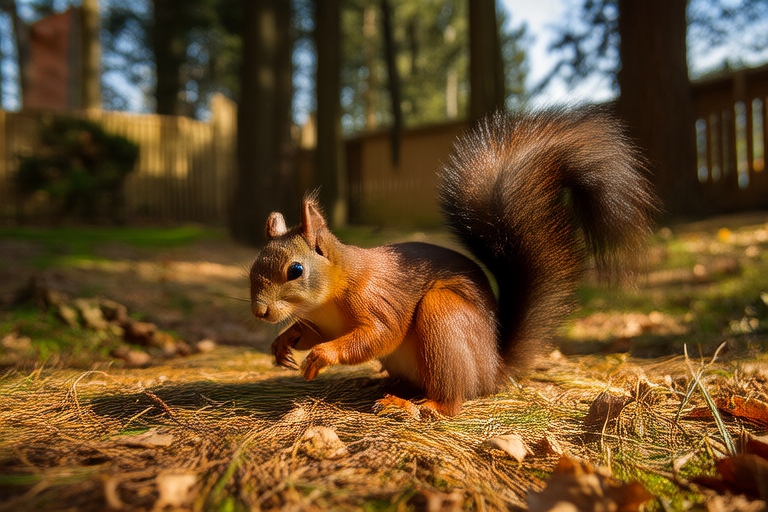From Backyards to Forests: The Incredible Journey of a Squirrel
In the bustling heart of our cities, a small but mighty creature scurries across our backyards, parks, and streets. The common backyard squirrel, a familiar sight to many, is a marvel of agility and adaptability. These bushy-tailed acrobats have made themselves at home in urban environments, where they navigate complex mazes of trees, power lines, and rooftops with remarkable ease. Their nimble movements and quick reflexes make them a joy to watch, yet few realize the incredible journey these creatures undertake as they venture beyond our city limits into the vast, untamed forests.
The Urban Squirrel: A City Dweller’s Best Friend
Urban squirrels are primarily gray or red in color, with some variations depending on their region. They thrive in environments that provide them with ample food sources and safe nesting sites. In cities, they find refuge in parks, gardens, and even backyards, where they feast on a diverse diet that includes nuts, seeds, fruits, and occasionally bird feeders. Their ability to adapt to human presence is one of their most impressive traits. Squirrels have learned to exploit human leftovers, scavenging from trash cans and picnic areas. This resourcefulness has allowed them to flourish in urban settings, where they face fewer natural predators than in the wild.
These animals are also known for their playful antics, often seen chasing each other up and down trees or engaging in mock battles. Their curiosity and energy make them delightful companions for city dwellers. However, this close proximity to humans also exposes them to dangers such as cars, dogs, and environmental pollutants. Despite these challenges, urban squirrels continue to thrive, proving their resilience and adaptability.
Venturing Deeper: The Forest Squirrel’s World
While urban squirrels have adapted to life among us, their forest-dwelling cousins face a different set of challenges. As they venture deeper into the woods, these squirrels must rely on their keen senses and survival instincts to navigate the dense underbrush and towering trees. The forest provides a rich habitat, but it also demands a high level of skill and determination. Forest squirrels must contend with harsh weather conditions, limited food supplies, and the constant threat of predators.
One of the most remarkable aspects of forest squirrels is their ability to store food for the winter months. They bury nuts and seeds throughout their territory, creating caches that serve as a vital source of sustenance during lean times. This behavior, known as scatter hoarding, is crucial for their survival, as it allows them to access food even when it’s scarce. The process of gathering and storing food requires a keen memory and spatial awareness, as squirrels must remember the location of thousands of hidden caches.
A Vital Role in Forest Ecosystems
Forest squirrels play a critical role in maintaining the health of their ecosystem. As seed dispersers, they contribute to the regeneration of trees and plants. When they gather and store seeds, they inadvertently plant new trees, helping to ensure the continuity of forest growth. This relationship between squirrels and plants is mutually beneficial, as the trees provide food and shelter for the squirrels while the squirrels aid in the propagation of new trees.
Another important aspect of their role in the forest is their nesting habits. Squirrels construct intricate nests, known as dreys, in the branches of trees. These nests serve as safe havens for the squirrels and their young, protecting them from the elements and potential predators. The construction of dreys requires a significant amount of effort, as squirrels gather leaves, twigs, and other materials to build sturdy, insulated homes. This process not only provides shelter for the squirrels but also contributes to the overall structure of the forest canopy.
The Impact of Human Interactions
Human activities have a profound impact on squirrel populations, both in urban and forest environments. While urban squirrels benefit from the abundance of food and resources provided by human settlements, they also face increased risks from pollution, traffic, and domestic pets. In contrast, forest squirrels are threatened by deforestation, habitat fragmentation, and climate change. These factors disrupt the delicate balance of their ecosystems, making it harder for them to survive and thrive.
To support the thriving of squirrel populations, it’s essential to adopt sustainable practices that protect their habitats. This includes preserving green spaces in urban areas, planting native trees, and reducing pollution. In forested regions, efforts to conserve and restore natural habitats can help ensure the survival of these vital creatures. Additionally, raising awareness about the importance of squirrels in our ecosystems can inspire individuals and communities to take action.
One inspiring example of community involvement is the creation of wildlife corridors, which connect fragmented habitats and allow animals to move safely between them. These corridors provide a safe passage for squirrels and other wildlife, enabling them to access food, water, and mates. By supporting the establishment of these corridors, we can help ensure the continued existence of these fascinating creatures.
Conclusion: A Call to Action
The journey of a squirrel, from the safety of our backyards to the depths of the forest, is a testament to their resilience and adaptability. These creatures, though small in size, play a vital role in maintaining the health and balance of their ecosystems. By understanding and appreciating their unique contributions, we can work together to protect and preserve their habitats. Whether in the city or the countryside, squirrels remind us of the beauty and complexity of nature, and the importance of coexistence.
Let us embrace the opportunity to learn from these remarkable animals and take steps to support their thriving in both backyards and forests. By doing so, we not only protect the squirrels but also contribute to the well-being of our planet. The incredible journey of a squirrel is a story of survival, adaptation, and resilience that continues to inspire and captivate us all.
